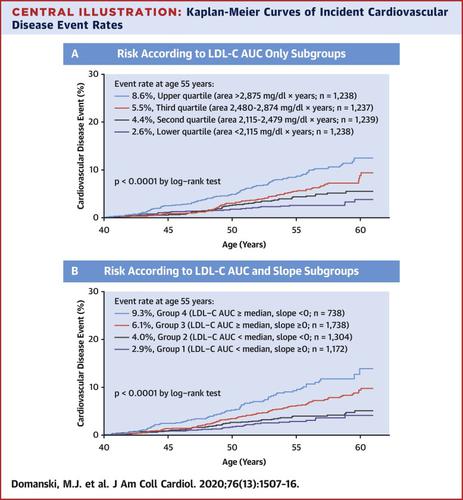当前位置:
X-MOL 学术
›
J. Am. Coll. Cardiol.
›
论文详情
Our official English website, www.x-mol.net, welcomes your
feedback! (Note: you will need to create a separate account there.)
Time Course of LDL Cholesterol Exposure and Cardiovascular Disease Event Risk
Journal of the American College of Cardiology ( IF 21.7 ) Pub Date : 2020-09-01 , DOI: 10.1016/j.jacc.2020.07.059 Michael J Domanski 1 , Xin Tian 2 , Colin O Wu 2 , Jared P Reis 3 , Amit K Dey 4 , Yuan Gu 5 , Lihui Zhao 6 , Sejong Bae 7 , Kiang Liu 6 , Ahmed A Hasan 3 , David Zimrin 1 , Michael E Farkouh 8 , Charles C Hong 1 , Donald M Lloyd-Jones 6 , Valentin Fuster 9
Journal of the American College of Cardiology ( IF 21.7 ) Pub Date : 2020-09-01 , DOI: 10.1016/j.jacc.2020.07.059 Michael J Domanski 1 , Xin Tian 2 , Colin O Wu 2 , Jared P Reis 3 , Amit K Dey 4 , Yuan Gu 5 , Lihui Zhao 6 , Sejong Bae 7 , Kiang Liu 6 , Ahmed A Hasan 3 , David Zimrin 1 , Michael E Farkouh 8 , Charles C Hong 1 , Donald M Lloyd-Jones 6 , Valentin Fuster 9
Affiliation

|
BACKGROUND
Incident cardiovascular disease (CVD) increases with increasing low-density lipoprotein cholesterol (LDL-C) concentration and exposure duration. Area under the LDL-C versus age curve is a possible risk parameter. Data-based demonstration of this metric is unavailable and whether the time course of area accumulation modulates risk is unknown. OBJECTIVES
Using CARDIA (Coronary Artery Risk Development in Young Adults) study data, we assessed the relationship of area under LDL-C versus age curve to incident CVD event risk and modulation of risk by time course of area accumulation-whether risk increase for the same area increment is different at different ages. METHODS
This prospective study included 4,958 asymptomatic adults age 18 to 30 years enrolled from 1985 to 1986. The outcome was a composite of nonfatal coronary heart disease, stroke, transient ischemic attack, heart failure hospitalization, cardiac revascularization, peripheral arterial disease intervention, or cardiovascular death. RESULTS
During a median 16-year follow-up after age 40 years, 275 participants had an incident CVD event. After adjustment for sex, race, and traditional risk factors, both area under LDL-C versus age curve and time course of area accumulation (slope of LDL-C curve) were significantly associated with CVD event risk (hazard ratio: 1.053; p < 0.0001 per 100 mg/dl × years; hazard ratio: 0.797 per mg/dl/year; p = 0.045, respectively). CONCLUSIONS
Incident CVD event risk depends on cumulative prior exposure to LDL-C and, independently, time course of area accumulation. The same area accumulated at a younger age, compared with older age, resulted in a greater risk increase, emphasizing the importance of optimal LDL-C control starting early in life.
中文翻译:

低密度脂蛋白胆固醇暴露和心血管疾病事件风险的时间进程
背景 心血管疾病 (CVD) 的发病率随着低密度脂蛋白胆固醇 (LDL-C) 浓度和暴露持续时间的增加而增加。LDL-C 与年龄曲线下的面积是一个可能的风险参数。该指标的基于数据的演示不可用,面积积累的时间过程是否会调节风险尚不清楚。目标 使用 CARDIA(年轻成人冠状动脉风险发展)研究数据,我们评估了 LDL-C 下面积与年龄曲线与事件 CVD 事件风险的关系,以及通过面积积累的时间进程对风险的调节 - 风险是否增加不同年龄的面积增量不同。方法 这项前瞻性研究包括 1985 年至 1986 年招募的 4,958 名 18 至 30 岁无症状成年人。短暂性脑缺血发作、心力衰竭住院、心脏血运重建、外周动脉疾病干预或心血管死亡。结果 在 40 岁后的中位 16 年随访期间,275 名参与者发生了 CVD 事件。在调整性别、种族和传统风险因素后,LDL-C 与年龄曲线下的面积和面积积累的时间过程(LDL-C 曲线的斜率)均与 CVD 事件风险显着相关(风险比:1.053;p < 0.0001/100 mg/dl × 年;风险比:0.797/mg/dl/年;分别为 p = 0.045)。结论 事件 CVD 事件风险取决于累积的先前 LDL-C 暴露,并且独立地,面积累积的时间过程。与老年相比,年轻时积累的相同面积导致更大的风险增加,
更新日期:2020-09-01
中文翻译:

低密度脂蛋白胆固醇暴露和心血管疾病事件风险的时间进程
背景 心血管疾病 (CVD) 的发病率随着低密度脂蛋白胆固醇 (LDL-C) 浓度和暴露持续时间的增加而增加。LDL-C 与年龄曲线下的面积是一个可能的风险参数。该指标的基于数据的演示不可用,面积积累的时间过程是否会调节风险尚不清楚。目标 使用 CARDIA(年轻成人冠状动脉风险发展)研究数据,我们评估了 LDL-C 下面积与年龄曲线与事件 CVD 事件风险的关系,以及通过面积积累的时间进程对风险的调节 - 风险是否增加不同年龄的面积增量不同。方法 这项前瞻性研究包括 1985 年至 1986 年招募的 4,958 名 18 至 30 岁无症状成年人。短暂性脑缺血发作、心力衰竭住院、心脏血运重建、外周动脉疾病干预或心血管死亡。结果 在 40 岁后的中位 16 年随访期间,275 名参与者发生了 CVD 事件。在调整性别、种族和传统风险因素后,LDL-C 与年龄曲线下的面积和面积积累的时间过程(LDL-C 曲线的斜率)均与 CVD 事件风险显着相关(风险比:1.053;p < 0.0001/100 mg/dl × 年;风险比:0.797/mg/dl/年;分别为 p = 0.045)。结论 事件 CVD 事件风险取决于累积的先前 LDL-C 暴露,并且独立地,面积累积的时间过程。与老年相比,年轻时积累的相同面积导致更大的风险增加,











































 京公网安备 11010802027423号
京公网安备 11010802027423号